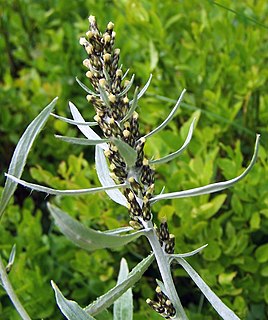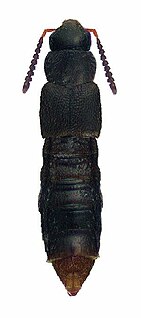
Northern krill, Meganyctiphanes norvegica, is a species of krill that lives in the North Atlantic Ocean. It is an important component of the zooplankton, providing food for whales, fish and birds. M. norvegica is the only species recognised in the genus Meganyctiphanes, although it has been known by several synonyms:
Old Norwegian, also called Norwegian Norse, is an early form of the Norwegian language that was spoken between the 11th and 14th century; it is a transitional stage between Old West Norse and Middle Norwegian, and also Old Norn and Old Faroese.

Nanahughmilleria is a genus of eurypterid, an extinct group of aquatic arthropods. Fossils of Nanahughmilleria have been discovered in deposits of Devonian and Silurian age in the United States, Norway, Russia, England and Scotland, and have been referred to several different species.

Crossota norvegica is a species of hydrozoan in the family Rhopalonematidae. It is closely related to Crossota millsae and is found in the Arctic Ocean at depths below 1,000 m (3,300 ft). Crossota norvegica is also known as the deep red jellyfish. This species is described as "alien-like" and is known for its vibrant red hue. It is a small cnidarian, reaching only up to 2 cm in its body size.

Sagebrush is the common name of several woody and herbaceous species of plants in the genus Artemisia. The best known sagebrush is the shrub Artemisia tridentata. Sagebrushes are native to the North American west.

Gnaphalium norvegicum, the highland cudweed or Norwegian arctic cudweed, is a European species of plants in the family Asteraceae. It is widespread across much of Europe from the Mediterranean north to Finland and Iceland.

Potentilla norvegica is a species of cinquefoil known by the common names rough cinquefoil, ternate-leaved cinquefoil, and Norwegian cinquefoil. It is native to Europe, Asia, and parts of North America, and it can be found elsewhere as an introduced species.

Dinophysis norvegica is a species of dinoflagellate most commonly associated with diarrheal shellfish poisoning.
Bibliotheca Norvegica is a four-volume bibliography of Norwegian literature edited by Hjalmar Pettersen. The four volumes were published between 1899 and 1924, and comprise together more than 3,300 pages. The first volume is titled Norsk boglexikon 1643–1813 and features a register of Norwegian books published prior to 1814. The second is titled Norge og nordmænd i udlandets literatur, registering Norway and the Norwegian people in non-Norwegian literature. The third has the title Norske forfattere før 1814 and the fourth Norske forfattere efter 1814, recording the works of Norwegian writers before and after 1814, respectively. Pettersen had also commenced on the fifth and the sixth volume of the bibliography before his retirement in 1926, but these were never finished, owing to his death in 1928. Every volume also has an English title, even though the bibliography was published in Christiania, Norway.

Arenaria norvegica, also known as Arctic, English or Norwegian sandwort, is a low growing plant in the family Caryophyllaceae, found in northwest Europe. The diploid chromosome number is 2n=80. There are two recognised subspecies.

Artemisia norvegica is a species of flowering plant in the aster family known by the common names alpine sagewort, boreal sagewort, mountain sagewort, Norwegian mugwort, arctic wormwood, and spruce wormwood. It is found in cold locations in Eurasia and high altitudes and high latitudes in North America.

Regesta Norvegica is a chronological inventory of all known documents relating to the history of Norway during the Middle Ages. The series contains summaries in modern Norwegian of medieval documents concerning Norway and Norwegian affairs.
Thermodesulforhabdus norvegica is a species of thermophilic sulfate-reducing bacteria, the type and only species of its genus. It is gram-negative, acetate-oxidizing, with type strain A8444.
Eunice norvegica is an aquatic polychaete worm found in deep water on the seabed of the northern Atlantic Ocean as well as in the Pacific and Indian Oceans. It is a tubeworm and is often associated with deep water corals.

Leptusa carolinensis is a species of rove beetle in the family Staphylinidae. It is found in North America.
Leptusa pusio is a species of rove beetle in the family Staphylinidae. It is found in North America.
Clubiona norvegica is a species of sac spider in the family Clubionidae. It is found in North America, Europe, and Russia (European).

Draba norvegica is a species of flowering plant in the mustard family (Brassicaceae) know by the common names Norwegian draba and Norwegian whitlow grass.

Leptusa ruficollis is a species of beetle belonging to the family Staphylinidae.
Proutia norvegica is a species of moth belonging to the family Psychidae.












